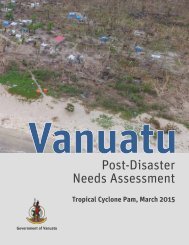Fiji
yqgk302EGjo
yqgk302EGjo
Create successful ePaper yourself
Turn your PDF publications into a flip-book with our unique Google optimized e-Paper software.
FIJI Post-Disaster Needs Assessment<br />
Per capita production losses, F$/person<br />
8,000<br />
7,000<br />
6,000<br />
5,000<br />
4,000<br />
3,000<br />
2,000<br />
1,000<br />
0<br />
Bua<br />
Lomaiviti<br />
Ra<br />
Cakaudrove<br />
Lau<br />
0 5,000 10,000 15,000 20,000 25,000 30,000 35,000<br />
Average Annual Household Income, F$<br />
Figure 6: Relationship between Per Capita Production Losses and Average Annual Household Income Arising from TC<br />
Winston<br />
Source: Estimations by Assessment Team.<br />
Note: The sizes of the balls in the above figure represent the ratio between production losses and household income.<br />
Summary of Economic and Social Impact<br />
Summary of Economic Impact<br />
The macroeconomic impact of TC Winston in 2016 is expected to be substantial given the significant damage incurred,<br />
particularly to key sectors, such as housing, transport, manufacturing, agriculture, electricity and communications. The<br />
losses resulting from TC Winston are estimated to reduce economic growth by 2.5 percent relative to the 2016 pre-cyclone<br />
forecast, bringing the growth rate down from 3.8 percent to 1.3 percent. However, taking into account the possible effect<br />
of recovery and reconstruction activities, assuming they start during 2016, the GDP growth rate is expected to be 2.4<br />
percent, which is a decrease of 1.4 percent compared to the pre-cyclone baseline estimate. This revised growth also<br />
reflects the expected impact of TC Zena, which passed southeast of <strong>Fiji</strong> only six weeks after TC Winston, causing torrential<br />
rain and major flooding.<br />
The impact of TC Winston on the performance of the balance-of-payments in 2016 will be quite substantial, due to exports<br />
declining relative to pre-cyclone forecasted levels. Total exports are now projected to decline by 1.2 percent in 2016<br />
compared to over 17 percent growth anticipated prior to the cyclone. Imports will be higher than previously expected<br />
with an inflow of machinery, equipment and materials for reconstruction and replacement of infrastructure in the housing,<br />
education, telecommunication and transport sectors. Food imports are also expected to increase due to the loss of locally<br />
grown produce. These impacts will raise the trade in goods deficit by 18.5 percent this year, which, as a percent of GDP,<br />
is now estimated to increase from 27.3 percent to 32.4 percent in 2016. The cyclone had minimal impact on the tourism<br />
sector, which is expected to fully recover during 2016. Aid in-kind and cash grants have risen following the cyclone and<br />
reconstruction financing is expected to result in higher inflows during 2016 and beyond. Overall, <strong>Fiji</strong>’s Balance of Payments<br />
Current Account deficit for 2016 is estimated to increase by 8.9 percent, driven by lower export earnings and higher import<br />
payments. This will raise the Current Account deficit to 12.9 percent of GDP (at market price) in 2016.<br />
There will be a number of negative impacts on the government’s fiscal balance. Government expenditure on disaster relief<br />
and early recovery activities are being funded through the reprioritization of line ministry budgets. Notable reallocations<br />
include top ups for social welfare programmes and food ration distribution. In addition, around F$70 million will be set<br />
aside for the upcoming residential rehabilitation and assistance programme (Help for Homes), and the diversion of funds<br />
into relief, recovery and reconstruction will reduce funds available for the government’s existing development programmes.<br />
Large additional expenditures are expected to be required once the reconstruction and recovery programmes are fully<br />
specified. In terms of impacts on revenue, value added tax (VAT) collections are expected to decline by about F$61.9 million<br />
during 2016 and there will be reductions in the Service Turnover Tax as a result of losses in the tourism sector.<br />
Tropical Cyclone Winston, February 20, 2016<br />
15



